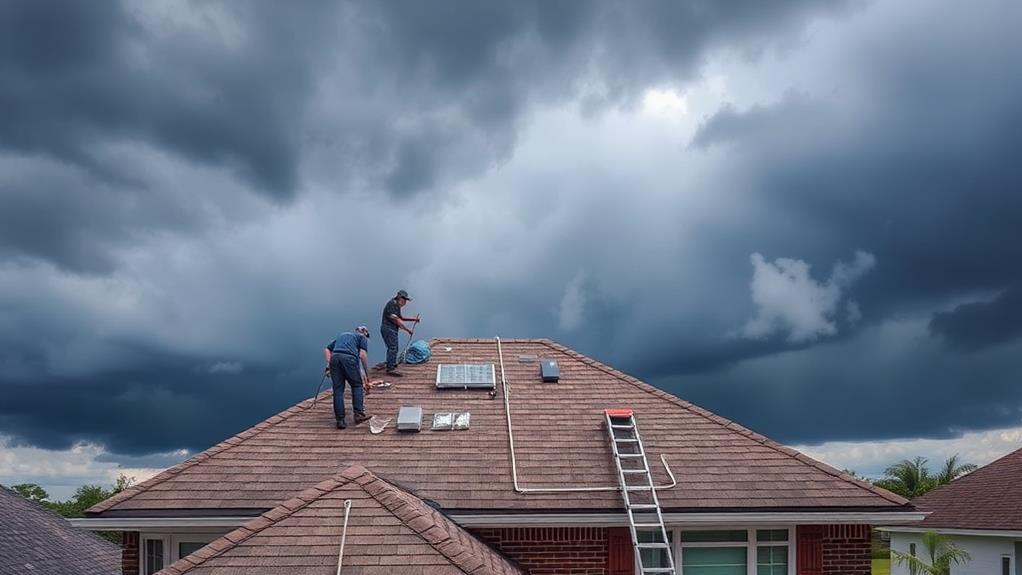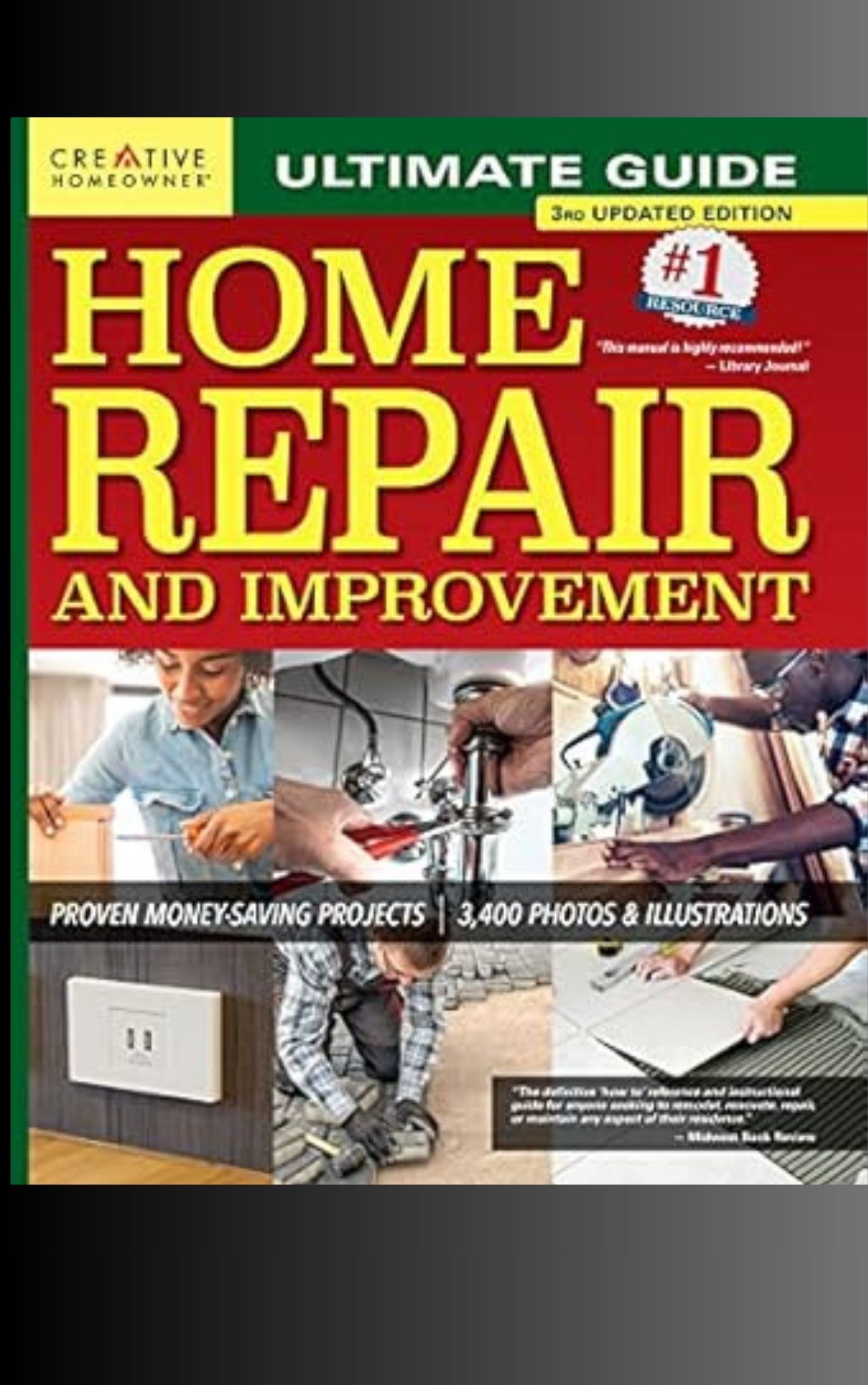Regular roof maintenance is essential for storm season preparation. Start by inspecting your roof twice yearly, focusing on shingles, flashing, and gutters. Clean gutters and downspouts to ensure proper water drainage. Trim overhanging tree branches to reduce debris accumulation and potential damage. Repair any damaged shingles promptly and check flashing and seals around roof penetrations. Reinforce weak areas and consider installing storm-resistant features like impact-resistant shingles or hurricane straps. Professional roof inspections can identify subtle issues and provide comprehensive assessments. By following these steps, homeowners can significantly improve their roof's resilience against severe weather. Discover more ways to protect your home from storm damage.
Inspect Your Roof Regularly

Regular roof inspections are a cornerstone of effective seasonal maintenance. By conducting thorough examinations of your roof at least twice a year, preferably in spring and fall, you can identify potential issues before they escalate into costly repairs. During these inspections, focus on key areas such as shingles, flashing, gutters, and vents.
Look for signs of wear and tear, including curled, cracked, or missing shingles, as well as damaged flashing around chimneys and skylights. Check for any signs of water damage, such as stains on ceilings or walls, which may indicate leaks. Ensure gutters are clear of debris and securely attached to prevent water from backing up and causing damage to the roof structure.
For safety reasons, consider using binoculars to inspect your roof from the ground. If you're comfortable climbing a ladder, examine the roof's edge and accessible areas. However, for a comprehensive inspection, especially on steep or high roofs, it's advisable to hire a professional roofing contractor. They can safely assess hard-to-reach areas and provide expert insights on your roof's condition and any necessary maintenance or repairs.
Clean Gutters and Downspouts
Keeping your gutters and downspouts clear of debris is a crucial aspect of seasonal roof maintenance. Clogged gutters can lead to water backup, which may cause damage to your roof, fascia, and soffit. Regular cleaning prevents these issues and ensures proper water drainage away from your home's foundation.
To clean gutters effectively, start by removing large debris by hand or with a small plastic scoop. Flush remaining dirt with a garden hose, working from the far end towards the downspout. If water doesn't flow freely, use a plumber's snake to clear obstructions in the downspouts. For two-story homes or steep roofs, consider hiring a professional to avoid safety risks.
Aim to clean gutters at least twice a year, typically in spring and fall. However, homes surrounded by trees may require more frequent cleaning. Install gutter guards to reduce debris accumulation and minimize maintenance needs. When cleaning, inspect gutters for signs of damage, such as cracks, rust, or separated seams. Address these issues promptly to prevent water damage and maintain your roof's integrity. Remember, well-maintained gutters and downspouts play a vital role in protecting your home from water-related damage during storm season.
Trim Overhanging Tree Branches

Trimming overhanging tree branches is a critical component of seasonal roof maintenance. Branches that extend over your roof pose several risks, especially during storm season. Strong winds can cause these limbs to scrape against shingles, damaging protective granules and potentially creating weak spots. In severe cases, heavy branches may break off entirely, puncturing the roof and leading to costly repairs.
To mitigate these risks, inspect trees near your home regularly and identify any branches within 10 feet of your roof. Use proper pruning techniques to remove these limbs, cutting them back to the nearest healthy lateral branch or the trunk itself. For larger trees or those close to power lines, it's advisable to hire a professional arborist to ensure safe and effective trimming.
In addition to protecting your roof, trimming overhanging branches offers other benefits. It reduces leaf and debris accumulation in gutters, minimizes the risk of pests accessing your roof, and allows more sunlight to reach your shingles, helping to prevent moss and algae growth. By maintaining a clear space above your roof, you'll significantly enhance its longevity and performance during storm season.
Repair Damaged Shingles
Consistently inspecting and repairing damaged shingles is a crucial aspect of seasonal roof maintenance. Regular checks can prevent minor issues from escalating into costly repairs or full roof replacements.
Look for signs of wear, such as curling edges, cracks, or missing granules, which can compromise the roof's integrity and lead to leaks.
When repairing damaged shingles, start by carefully lifting the edges of surrounding shingles to access the damaged area. Remove any nails securing the damaged shingle and slide it out. Replace it with a new shingle of the same size and material, ensuring proper alignment with adjacent shingles. Secure the new shingle with roofing nails and seal the edges with roofing cement.
For minor damage, such as small tears or lifted edges, applying roofing cement under the damaged area may suffice. However, extensive damage or multiple problem areas may require professional intervention.
Always prioritize safety when working on a roof, using proper equipment and considering weather conditions. If you're unsure about your ability to safely repair shingles, it's best to consult a professional roofing contractor to ensure the job is done correctly and maintain your roof's longevity.
Check Flashing and Seals

As you inspect your roof, paying close attention to flashing and seals is crucial for maintaining its integrity. Flashing, typically made of metal or rubber, is installed around chimneys, vents, skylights, and other roof penetrations to prevent water infiltration. Over time, these materials can deteriorate or become loose, compromising their effectiveness.
Begin by examining the flashing for signs of damage, such as cracks, rust, or separation from the roof surface. Ensure that all seams are properly sealed and that there are no gaps where water could enter. Pay special attention to areas where different roofing materials meet, as these junctions are particularly vulnerable to leaks.
Next, inspect the seals around vents, pipes, and other roof fixtures. Look for cracking, peeling, or shrinkage in the sealant material. If you notice any issues, clean the area thoroughly and apply a new layer of appropriate roofing sealant. For more complex problems or if you're unsure about the condition of your flashing and seals, it's advisable to consult a professional roofer. Regular maintenance of these critical components can significantly extend the lifespan of your roof and prevent costly water damage.
Reinforce Weak Areas
Vigilance in identifying and reinforcing weak areas of your roof is essential for preventing future problems. Regular inspections can reveal potential vulnerabilities that, if left unaddressed, may lead to leaks or structural damage during severe weather. Common weak points include aging shingles, deteriorating sealants, and areas prone to water pooling.
To reinforce these areas, start by replacing damaged or missing shingles. Use roofing cement to secure loose shingles and seal exposed nail heads. Pay special attention to the roof's edges, valleys, and areas around chimneys or vents, as these are often susceptible to water intrusion. Apply a waterproof sealant to these critical junctures to enhance their resilience.
For flat or low-slope roofs, address any areas of standing water by improving drainage or applying a waterproof coating. Reinforce the roof deck by installing additional fasteners or support beams if necessary. In regions prone to high winds, consider adding hurricane straps or clips to strengthen the roof-to-wall connection. These measures can significantly improve your roof's ability to withstand harsh weather conditions and extend its overall lifespan.
Install Storm-Resistant Features

Installing storm-resistant features builds upon the reinforcement of weak areas, providing an additional layer of protection for your roof. These features are designed to withstand severe weather conditions and minimize potential damage. Start by installing impact-resistant shingles, which are engineered to resist hail and high winds. These shingles are often made from materials like modified asphalt or rubber, offering superior durability compared to standard options.
Next, consider adding hurricane straps or clips to secure the roof to the walls of your home. These metal connectors significantly increase the roof's resistance to uplift forces during strong winds. Install a drip edge along the roof's perimeter to prevent water from seeping under the shingles and causing damage to the underlying structure. For extra protection against water infiltration, apply a waterproof underlayment beneath the shingles.
Schedule Professional Roof Inspection
While DIY maintenance is valuable, scheduling regular professional roof inspections is crucial for comprehensive care and early problem detection. Experienced roofers possess the expertise to identify subtle issues that may escape the untrained eye, potentially preventing costly repairs down the line.
Professional inspectors use specialized tools and techniques to assess the roof's structural integrity, including infrared cameras to detect hidden moisture and thermal anomalies. They examine flashing, gutters, chimneys, and ventilation systems, ensuring all components function optimally.
It's advisable to schedule bi-annual inspections, ideally in spring and fall, to prepare for extreme weather conditions. After severe storms, additional inspections may be necessary to assess potential damage. When selecting a roofing professional, choose a licensed, insured contractor with positive references and a track record of quality work.
During the inspection, the roofer should provide a detailed report outlining the roof's condition, any existing issues, and recommended repairs or maintenance. This documentation is valuable for insurance purposes and helps homeowners make informed decisions about roof care and potential upgrades to enhance storm resistance.
Frequently Asked Questions
How Often Should I Replace My Roof?
The frequency of roof replacement depends on various factors, including roofing material, climate, and maintenance. Generally, asphalt shingles last 20-30 years, metal roofs 40-70 years, and slate or tile roofs can exceed 100 years with proper care.
What's the Best Roofing Material for Storm-Prone Areas?
For storm-prone areas, impact-resistant materials like metal, slate, or clay tiles are excellent choices. These durable options offer superior wind and hail resistance. Additionally, architectural shingles with high wind ratings provide a cost-effective alternative for enhanced storm protection.
Can I Apply Waterproof Coatings to My Roof Myself?
Like a shield against nature's fury, waterproof coatings can be applied by homeowners. However, professional application is recommended for optimal results. DIY application risks improper coverage, reduced effectiveness, and potential warranty issues. Consult a roofing expert for best practices.
How Much Does a Typical Roof Insurance Claim Cost?
The average roof insurance claim cost varies widely, typically ranging from $5,000 to $15,000. Factors influencing the cost include roof size, damage extent, materials needed, and local labor rates. Deductibles and policy terms also affect out-of-pocket expenses.
Are Impact-Resistant Shingles Worth the Extra Cost?
Impact-resistant shingles, coincidentally, can be worth the extra cost. They offer enhanced durability and protection against hail and debris, potentially reducing insurance premiums and future repair expenses. However, their value depends on your specific location and climate conditions.
Conclusion
In conclusion, diligent seasonal roof maintenance is crucial for safeguarding homes against the ravages of storm season. Like a vigilant sentinel atop a fortress, a well-maintained roof stands as the first line of defense against nature's onslaught. Studies show that proactive maintenance can extend a roof's lifespan by up to 25 years. By following these essential steps, homeowners can ensure their roofs remain resilient, protecting the sanctuary beneath from the tempests that rage above.

